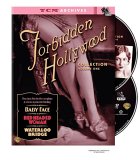What we have here are three films from Hollywood’s days before the Production Code kicked in, which show just how much the envelope was being pushed when it came to sexual subject matters. The recurring theme here is sex as a commodity, whether the situations beinig dealt with involve outright prostitution or not.
Outright prostitution is very much the issue in Waterloo Bridge (1931), director James Whale’s effort just prior to making Frankenstein. Mae Clarke (who would play Elizabeth in Frankenstein) is an out-of-work chorus girl during WWI, not a prostitute trolling for men on the titular bridge. During an air raid she runs into a young private from a good family (Kent Douglass). He falls in love with her, and she with him, and so she tries to push him away. This is a romance that is anything but glamorous, despite some scenes in the upper class household (with a young Bette Davis as Douglass’ sister), and the resolution is brutally downbeat.
Somewhat lighter is Red-Headed Woman (1932), where Jean Harlow is the girl of humble origins who breaks up the marriage of Chester Morris with the idea of marrying into high society, and she’ll marry more than once if need be. Harlow is a real piece of work as she uses sex to trap her targets (weak-willed idiots to a man), and the ending is still rather startling today, and would have broken every conceivable aspect of the Code a few years later.
These two films are pretty fine, but the stand-out is Baby Face (1933). Barbara Stanwyck, like Harlow, sleeps her way up the corporate ladder, but her character is simultaneously far more sympathetic and far more frightening. Her sexual warfare is couched in Nietzschean terms, as a satanic Geppetto figure (Alphonse Ethier) brandishes The Will to Power in her face and urges her to “use men!” This she does, and her piercing, absolute-zero gaze makes it clear that when it comes to predators, the likes of the Alien, Jaws and the Terminator are a long way down on the food chain from her. Unlike Harlow’s character, however, Stanwyck seduces the audience as thoroughly as the nitwits who surround her, and we cheer her along, trembling all the while. The film comes in two versions, and the pre-release contains some utterly jaw-dropping scenes that were cut from the theatrical version. There is no nudity here, but a frankness towards the sexuality of the protagonist that is almost unimaginable even today.
Audio
The original mono soundtracks are what’s on offer here. By and large, they’re pretty clean. Waterloo Bridge suffers from the most distortion and static, but it must be remembered that this is still an instance of a very early sound film. What is more of a flaw in the transfer, though, is the exceedingly low volume on this film. The other two will still have you turning up the sound, but not quite as much.
Video
Again, considering the age of the films, the transfers are all quite impressive. Waterloo Bridge has the most grain and a few instances of very noticeable guitar strings, but even it looks pretty good. The black-and-white tones of all three films are very nice, too. The theatrical version of Baby Face is the exception – the image is murky and the print is quite badly speckled. But as the pre-release looks terrific and is uncut, there’s not much point in watching the theatrical cut anyway.
Special Features
There’s the trailer for Baby Face and a short introduction to the set by Robert Osborne, setting the historical stage, but that’s it. I should also note that the discs are mislabeled.
Closing Thoughts
Though short on extras, the set is remarkable for the films it present. This is a marvellous treat.






